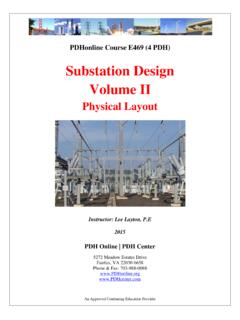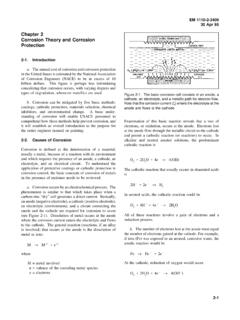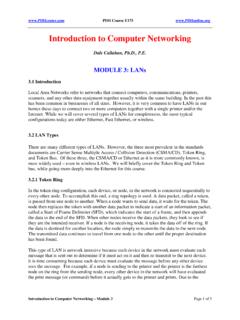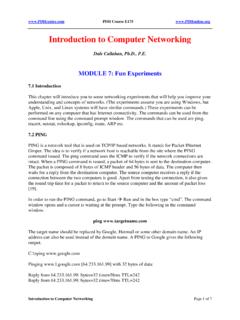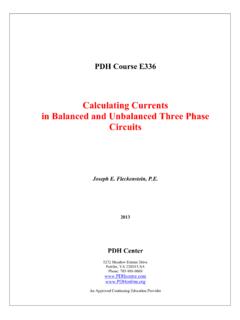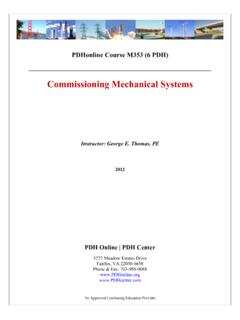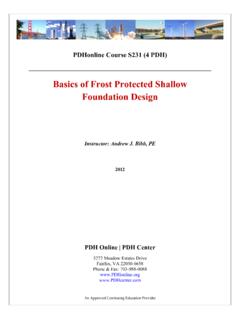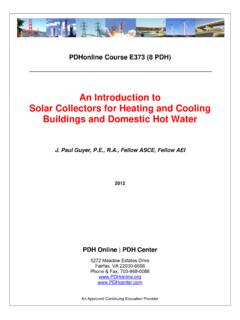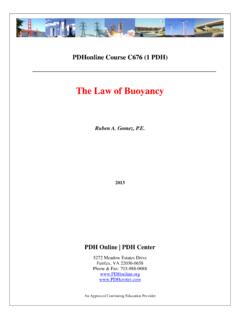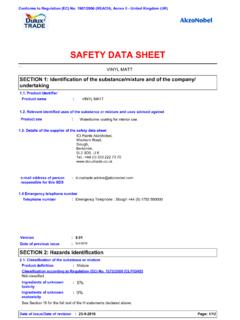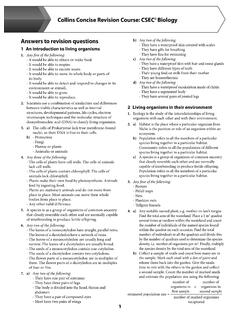Transcription of Clean Steam Systems in the Pharmaceutical Industry
1 PDH Course K109 Page 1 of 19 Clean Steam in the Pharmaceutical Industry Tim Latham, , , MIChemE. COURSE CONTENT 1. What is Clean Steam ? Clean Steam is used in the Pharmaceutical and healthcare industries in processes where the Steam or its condensate can come into contact with a Pharmaceutical or medical product and cause contamination. In such cases, Steam from a conventional boiler (often called utility or plant Steam ) is unsuitable because it may contain boiler additives, rust or other undesirable materials. The use of Clean Steam is determined by the rules of Good Manufacturing Practice (GMP). These are general rules applicable to Pharmaceutical manufacture, detailed in the Code of Federal Regulations (CFR Title 21, Part 211).
2 They do not provide any specific recommendations regarding Steam , but do present the general requirements of facilities, Systems , equipment and operation needed to prevent contamination of Pharmaceutical products during their manufacture. 2. Uses of Clean Steam The main use of Clean Steam in Pharmaceutical manufacturing is for the sterilization of products or, more usually, equipment. Steam sterilzation is encountered in the following processes : Manufacture of injectable or parenteral solutions, which are always sterile. Biopharmaceutical manufacturing, where a sterile environment must be created to grow the biological production organism (bacterium, yeast or animal cell). Manufacture of sterile solutions, such as ophthalmic products.
3 Typically in these processes, Clean Steam is injected into equipment or piping to create a sterile environment, or into autoclaves where loose PDH Course K109 Page 2 of 19equipment, components (such as vials and ampoules) or products are sterilized. Clean Steam may be used for some other functions where conventional utility Steam might cause contamination, such as : Humidification in some Clean rooms. Injection into high purity water for heating prior to Clean -in-Place (CIP) operations. 3. Clean Steam purity Before discussing the purity required of Clean Steam , it is first worth discussing the requirements for the purity of water used in Pharmaceutical manufacturing.
4 This is because Clean Steam purity is often defined by the purity of the condensate, and this is often referenced to one of the published water purity standards. Additionally, the parameters by which Pharmaceutical water purity is measured (conductivity, total organic carbon, endotoxins and microbial content) are those usually used for defining Clean Steam purity. There are statutory requirements regulating the purity of water used in Pharmaceutical manufacture, and two grades of high purity water are defined in the US Pharmacopoeia, namely Purified Water (PW) and Water for Injection (WFI). PW must meet a chemical specification for conductivity and total organic carbon (TOC), and a microbial specification. WFI is a higher purity water.
5 It must meet the same chemical specification as PW, but a much higher microbial specification. Additionally, it must meet a specification for endotoxins, and must be produced by a defined method (either distillation or reverse osmosis). TABLE 1 : USP 24 Specification for Water Purity Purified Water Water for Injection Conductivity < S/cm at 25 0C < S/cm at 25 0C Total Organic Carbon (TOC) <500 ppm <500 ppm Microbial (recommended Action Limit) 100 cfu/ml 10 cfu/100 ml Endotoxin No requirement < EU/ml Production Method Not Specified Either distillation or reverse osmosis PDH Course K109 Page 3 of 19 Microbial content is measured in colony forming units , or cfu this reflects the test method, in which water samples are spread on plates of growth medium and incubated, the number of microbial colonies that develop then being counted under a microscope.
6 The microbial specification for PW and WFI is set for each system by the Pharmaceutical manufacturer, but the pharmacopoeia guidelines for PW would be 100 cfu/ml, whereas for WFI it would be 10 cfu/100 ml. Endotoxins are breakdown products of dead microbes, often lipopolysaccharides from the cell walls of Gram negative bacteria. They are also called pyrogens, which is indicative of the main problem that they cause in patients pyrexia, or fever. The avoidance of endotoxins is therefore mainly of concern for parenteral Pharmaceutical products, which are injected into the patients. In contrast to water, there is no pharmacopoeia standard for Clean Steam (or any type of Steam for use in Pharmaceutical manufacturing). A specification for the purity of such Steam must be prepared by each manufacturer, and the specification must be such that they meet the GMP requirement to avoid contamination of the product.
7 In theory, there could be a wide range of different Clean Steam specifications, applicable to products of different degrees of purity and different stages of manufacture. In practice, the Pharmaceutical Industry has tended to consolidate around specifications where the Steam condensate meets the pharmacopoeia specification for PW or WFI. Probably the commonest Clean Steam specification is that the condensate meets WFI requirements for conductivity, TOC and endotoxin (The microbial limit is normally excluded as it is acknowledged that viable micro - organisms cannot survive, indeed are killed, in Steam Systems ). The WFI-based specification is used where an endotoxin limit is required, and this is important for injectables and parenteral products.
8 These are produced as sterile solutions and, since Clean Steam is primarily used for sterilization, they make-up the majority of manufacturing facilities where Clean Steam is used. A specification for Clean Steam may be based on the PW specification, and will thus be confined to chemical composition (TOC and conductivity). This would be appropriate in facilities producing products, or using processes, PDH Course K109 Page 4 of 19which must be sterile, but where endotoxin in the final product is not a concern. Example might include some biopharmaceutical processes, or the production of sterile ophthalmic solutions. Increasingly, processes of some bulk ingested liquids, such as mouthwashes, is undertaken in Steam -sterilized plant.
9 Finally in this section, it is important to discuss nomenclature. Although Clean Steam has been used throughout this course, and is used in the ISPE Baseline Guide, it is not used universally, and can have different meaning to different people. Terms such as Pure Steam , Pyrogen-free Steam and Low Endotoxin Steam are encountered in the Pharmaceutical Industry , and may have specifications that are the same or different to those of Clean Steam used on other sites. The important point is that each site or facility must have its own written specification for a grade of Steam used in its processes, and that that specification is appropriate to the manufacturing process in which it is used. In March 2000 the Water & Parenterals Subcommittee of the United States Pharmacopeia established definitions for Pure Steam and Pure Steam for Injection and recommended inclusion of these definitions in the "Water for Pharmaceutical Purposes" section of the USP.
10 At the time of writing this course, that recommendation had not yet been enacted. You may also encounter the term Clean Steam used for some types of utility Steam for example, it may be used for a type of Steam used in food manufacture, where the boiler additives used are approved by the FDA for food processing. Where nomenclature becomes confusing, concentrate on the purity specification, and from that develop the type of feedwater, generator and distribution system needed to meet that requirement. 4. Fundamentals of Clean Steam system design Before describing the details of generator and distribution design, it is worth reviewing some of the fundamental principles upon which their design is based. Avoidance of corrosion Unlike utility Steam , Clean Steam has no corrosion inhibitors.
